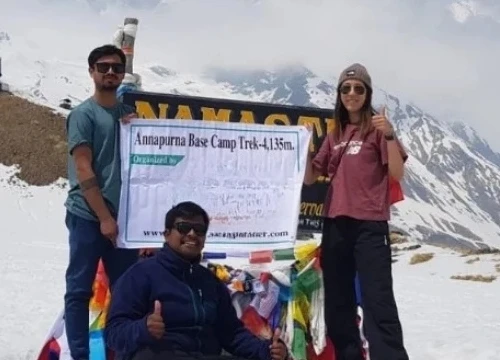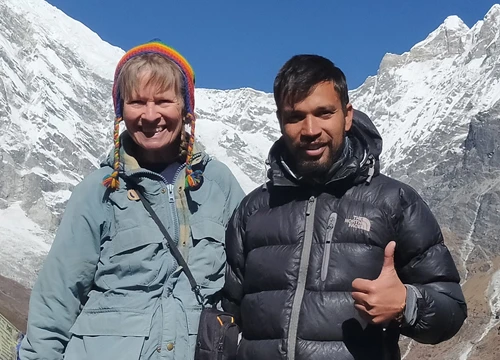Why should Hindus and Buddhists visit Kailash Manasarovar
The Kailash Mansarovar Yatra is a pilgrimage that holds immense importance in Hindu and Buddhist traditions. For Hindus, Mount Kailash is revered as the earthly abode of Lord Shiva, where he resides with his consort, Parvati. The mountain is considered one of the holiest sites in Hinduism, and undertaking the yatra is believed to bring about spiritual purification and enlightenment. Pilgrims often perform the parikrama, or circumambulation, of the mountain, which is a rigorous trek symbolizing reverence and devotion. The journey is not only a physical challenge but also a spiritual endeavor that strengthens one's faith and connection to the divine.
In Buddhism, Mount Kailash is known as Kang Rinpoche, which means "Precious Jewel of Snow." It is considered the center of the universe and the axis mundi in Buddhist cosmology. The mountain is associated with various Buddhist deities, including Demchok, who represents supreme bliss. The yatra to Kailash is seen as a path to achieving Nirvana, the ultimate state of liberation and freedom from the cycle of birth and rebirth. Pilgrims believe that circumambulating the sacred mountain erases the sins of a lifetime and paves the way for spiritual growth.
The significance of the yatra extends to Jainism and Bon, the indigenous religion of Tibet. For Jains, Mount Kailash is known as Ashtapada, where the first Tirthankara, Rishabhadeva, attained Nirvana. In Bon, the mountain is revered as the seat of all spiritual power. The convergence of these diverse religious beliefs at Kailash underscores its universal sanctity and the profound impact it has on the spiritual lives of countless devotees. The yatra is a unique opportunity to experience the confluence of different faiths and their shared reverence for this mystical site.
What is the Best Time for Kailash Manasarovar Yatra
Choosing the right time to embark on the Kailash Mansarovar Yatra is crucial for a successful and fulfilling experience. The ideal period for the yatra is during the summer months from May to September. During this time, the weather conditions are relatively favorable, with temperatures ranging from 15°C to 25°C during the day and dropping to around 0°C at night. The clear skies and moderate temperatures make trekking more manageable and allow pilgrims to appreciate the breathtaking landscapes of the Himalayas fully.
The months of May and June are particularly popular for the yatra, as they coincide with the auspicious Hindu festival of Saga Dawa, which celebrates the birth, enlightenment, and death of Lord Buddha. This period also offers the opportunity to witness the vibrant cultural festivities and rituals performed by Tibetan Buddhists. However, it is essential to note that this is also the peak season for the yatra, and pilgrims should be prepared for larger crowds and possibly longer waiting times for permits and accommodations.
July and August are the monsoon months, which can bring heavy rainfall and increased risk of landslides and roadblocks. While the lush greenery and blooming flowers add to the scenic beauty, the unpredictable weather can pose challenges for trekkers. September marks the end of the monsoon season, with clear skies and pleasant weather, making it another favorable time for the yatra. Regardless of the chosen time, it is essential to stay informed about the weather conditions and prepare accordingly to ensure a safe and enjoyable journey.
What are the Required Permits and Documentation for Kailash Mansarovar
Undertaking the Kailash Manasarovar Yatra requires careful planning and obtaining the necessary permits and documentation well in advance. Since the yatra involves traveling to remote and restricted areas in Tibet, pilgrims must secure several licenses. The most crucial document is the Tibet Travel Permit, issued by the Tibet Tourism Bureau. This permit is mandatory for all foreign travelers and is usually arranged through a registered travel agency.
In addition to the Tibet Travel Permit, pilgrims need the Aliens' Travel Permit, which allows access to restricted areas such as Mount Kailash and Lake Manasarovar. This permit is obtained once you arrive in Tibet. Furthermore, a Military Permit is required for visiting border areas, and a Foreign Affairs Permit is necessary for regions under the jurisdiction of the Foreign Affairs Office. These permits are typically coordinated by the travel agency handling your yatra arrangements.
What permits are required for Indians for the Kailash Mansarovar yatra
Indian pilgrims have an additional option to undertake the yatra through the Ministry of External Affairs (MEA), Government of India. The MEA organizes two routes: the Lipulekh Pass route in Uttarakhand and the Nathu La Pass route in Sikkim. Indian citizens opting for these routes must apply through the MEA website and participate in a selection process that includes a medical examination. It is crucial to carry all required documents, including a valid passport with at least six months of validity, a Chinese visa, and any other identification or health certificates as specified by the authorities.
Preparing Physically and Mentally for the Journey
The Kailash Manasarovar Yatra is a physically demanding and mentally challenging pilgrimage that requires thorough preparation. The high altitude, rugged terrain, and unpredictable weather conditions can test even the most seasoned trekkers. Therefore, it is essential to embark on a fitness regimen several months before the yatra. Focus on building stamina, strength, and cardiovascular endurance through activities such as walking, jogging, cycling, and hiking. Incorporate specific exercises to strengthen your legs, core, and lungs, as these will be crucial during the trek.
Acclimatization is a critical aspect of preparing for the yatra. The high altitudes can lead to altitude sickness, which can be debilitating and dangerous. Gradual acclimatization is key to minimizing the risk. Spend a few days at intermediate altitudes before ascending further, and ensure you stay hydrated and well-nourished. It is also advisable to consult a healthcare professional for advice on altitude sickness medication and other preventive measures. Mental preparation is equally important, as the yatra can be physically exhausting and emotionally taxing.
Meditation, yoga, and mindfulness practices can help in cultivating mental resilience and inner peace. These practices not only enhance physical flexibility and strength but also foster a calm and focused mind. Connecting with fellow pilgrims and seeking guidance from experienced trekkers can provide valuable insights and moral support. Remember that the yatra is as much a spiritual journey as it is a physical one. Embrace the challenges with a positive attitude and an open heart, and you will find the experience deeply rewarding.
What is the Essential Packing List for Pilgrims for Kailash Manasarovar Yatra
Packing wisely for the Kailash Manasarovar Yatra is crucial to ensure comfort and safety throughout the journey. Given the diverse Himalayan climate, it is crucial to be prepared for varying weather conditions. Layered clothing is essential to adapt to temperature fluctuations. Start with moisture-wicking base layers, followed by insulating mid-layers, and top it off with a waterproof and windproof outer shell. A good quality down jacket is indispensable for the cold nights and high-altitude passes.
Sturdy, waterproof trekking boots with good ankle support are a must for navigating the rocky and uneven terrain. Break in your boots well before the yatra to avoid blisters and discomfort. Additionally, pack several pairs of moisture-wicking socks, gloves, a warm hat, and a sun hat for protection against the elements. Sunglasses with UV protection and high SPF sunscreen are essential to shield yourself from the intense sun at high altitudes. A comfortable backpack with a rain cover will help carry your essentials during the trek.
Other essential items include a sleeping bag rated for low temperatures, a first aid kit with basic medications and altitude sickness remedies, a reusable water bottle with a filtration system, and energy snacks such as nuts, dried fruits, and energy bars. Personal hygiene items, including biodegradable soap, wet wipes, and hand sanitizer, are also necessary. Carry a headlamp with extra batteries, a multi-tool, and a trekking pole for added support. Finally, ensure you have copies of all permits, travel documents, and emergency contact information. Packing thoughtfully can make a significant difference in your overall yatra experience.
How are the Accommodation and Travel Options for Kailash Manasarovar
Accommodation and travel options for the Kailash Manasarovar Yatra vary depending on the route and travel arrangements. For pilgrims traveling through the Ministry of External Affairs (MEA), accommodation is provided at designated rest houses and campsites along the route. These facilities offer basic amenities such as dormitory-style rooms, shared bathrooms, and dining areas. While the accommodations are modest, they provide a comfortable resting place for weary pilgrims.
For those opting for a private or group tour organized by travel agencies, accommodation options may include guesthouses, lodges, and hotels in towns and villages along the way. In remote areas near Mount Kailash and Lake Manasarovar, pilgrims may stay in shared basic rooms equipped with sleeping tents, dining tents, and toilet tents. These campsites offer a more rustic experience, allowing pilgrims to connect with the natural surroundings. It is essential to set realistic expectations regarding accommodation, as facilities in remote regions may be limited and basic.
Travel options to reach the starting point of the yatra also vary. The Lipulekh Pass route involves traveling through Uttarakhand and crossing into Tibet, while the Nathu La Pass route involves traveling through Sikkim. Both routes require a combination of road travel and trekking. For those traveling independently or with private tours, the journey typically starts with a flight to Kathmandu, Nepal, followed by an overland journey to the Tibetan border. From there, pilgrims continue by road and on foot to reach Mount Kailash and Lake Manasarovar. Regardless of the chosen route, it is essential to plan your travel logistics carefully and account for any potential delays or changes in itinerary.
Health and Safety Tips During the Yatra
Ensuring your health and safety during the Kailash Manasarovar Yatra is paramount to having a successful pilgrimage. The high altitudes and rugged terrain can pose significant health risks, so it is essential to take precautionary measures. One of the primary concerns is altitude sickness, which can affect anyone regardless of fitness level. Symptoms include headache, nausea, dizziness, and shortness of breath. To minimize the risk, acclimatize gradually by spending time at intermediate altitudes before ascending further. Stay hydrated, avoid alcohol and caffeine, and eat light, nutritious meals.
Carrying a first aid kit with essential medications, including those for altitude sickness, is crucial. Consult your healthcare provider before the journey to discuss any specific health concerns and obtain necessary prescriptions. It is also advisable to have travel insurance that covers high-altitude trekking and emergency evacuation. In case of severe altitude sickness or other medical emergencies, immediate descent to lower altitudes is the most effective treatment. Familiarize yourself with the symptoms and be prepared to act if needed.
Maintaining personal hygiene is essential to prevent illnesses during the yatra. Use hand sanitizer frequently, especially before meals, and carry biodegradable soap and wet wipes for cleaning. Drink only purified or boiled water to avoid waterborne diseases. Additionally, be mindful of the weather conditions and dress appropriately to stay warm and dry. Avoid overexertion and take regular breaks to rest and acclimatize. By taking these health and safety precautions, you can ensure a safer and more enjoyable pilgrimage experience.
Things to Follow during Kailash Manasarovar Yatra in Tibet
- Respecting local customs and cultural practices is an integral part of the Kailash Manasarovar Yatra.
- The region is rich in religious and cultural heritage, and it is important for pilgrims to be mindful of their actions and behavior.
- When visiting monasteries, temples, and other sacred sites, dress modestly and remove your shoes before entering.
- Avoid pointing your feet towards religious statues or shrines, as this is considered disrespectful.
- Always walk clockwise around stupas and other sacred structures, following the traditional circumambulation practice.
- Photography is generally allowed in most areas, but it is courteous to ask for permission before taking photos of people, especially monks and residents.
- In some monasteries and sacred sites, photography may be restricted, so be sure to follow any posted guidelines.
- Show respect by maintaining a quiet and contemplative demeanor during religious ceremonies and rituals.
- Refrain from touching or disturbing religious artifacts, and avoid making loud noises or engaging in disruptive behavior.
- Interacting with the local community is an enriching part of the yatra experience.
- Approach these interactions with humility and an open heart.
- Learn a few basic phrases in the local language, such as greetings and expressions of gratitude, to show respect and appreciation.
- Be mindful of local customs regarding food and hospitality, and accept offerings graciously.
- By honoring the cultural and spiritual traditions of the region, you contribute to the preservation of its heritage and deepen your own pilgrimage experience.
Conclusion and Final Thoughts on the Yatra Experience
The Kailash Manasarovar Yatra is a transformative journey that offers a unique blend of physical challenge, spiritual fulfillment, and cultural immersion. As you prepare for this sacred pilgrimage, it is essential to equip yourself with the knowledge and resources needed for a successful journey. From understanding the significance of the yatra in various religious traditions to packing wisely for the diverse Himalayan climate, each aspect of preparation plays a vital role in ensuring a smooth and enriching experience.
Embracing the physical and mental challenges of the yatra with a positive attitude and an open heart can lead to profound personal growth and spiritual awakening. The journey to Mount Kailash and Lake Mansarovar is not just a trek through breathtaking landscapes but a path to inner peace and enlightenment. By respecting local customs and practices, you honor the sacredness of the region and contribute to the preservation of its cultural heritage.







